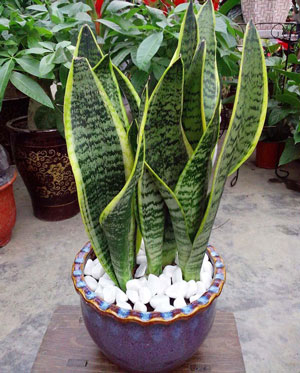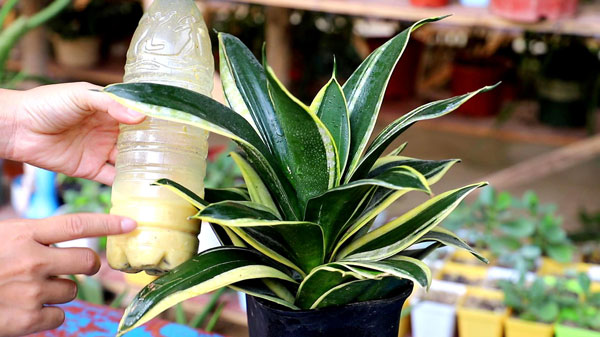Snake Plant (Sansevieria Trifasciata) Profile
Written by Iris
May 16 2022
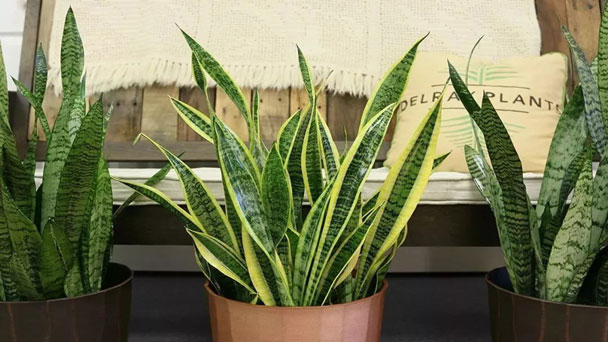
Snake Plant (Sansevieria trifasciata) is native to western Africa and is a plant of the genus Asparagaceae. Its leaves are firm and upright, with grayish-white and dark green tiger-tail-shaped horizontal stripes on the leaf surface. The posture is resolute and peculiar and interesting. It is a popular foliage plant. Snake Plant's flower language is "firm and fortitude."
Snake Plant infoSnake Plant CultureSnake Plant CharacteristicsSnake Plant Distribution AreaHow to Grow and Care for Snake PlantSnake Plant Light RequirementsSoil for Snake PlantSnake Plant WateringSnake Plant Temperature & Humidity CareFertilizer for Snake PlantUses of Snake PlantSnake Plant PropagationVarieties of Snake PlantCommon Pests/DiseasesSnake Plant Companion PlantsSnake Plant Toxicity
Snake Plant info
| Botanical Name | Sansevieria trifasciata |
| Common Name | Snake plant, viper's bowstring hemp, St. George's sword |
| Plant Type | Evergreen, perennial |
| Mature Size | 0.5 ft.–8 ft. tall |
| Sun Exposure | Partial |
| Soil Type | Sandy, well-drained |
| Soil pH | Slightly acidic to slightly alkaline |
| Bloom Time | Spring (blooms are rare) |
Snake Plant Culture
Winter hardy to USDA Zone 10-12. In St. Louis, this snake plant is an easy-to-grow houseplant that tolerates a wide range of cultural and environmental conditions. It prefers warm, bright locations, but tolerates some shade. Protect from hot afternoon sun. Best grown in a well-draining potting mix. Water regularly during the growing season, with significantly reduced watering from fall to late winter. Do not pour water on the center of the rosette. Clay pots that are wider than they are high are often used to make sure this tall and narrow plant is stable and does not topple over. Indoor plants may be placed in shady outside locations in summer. Propagate by leaf cuttings or dividing offsets.Snake Plant Characteristics
Sansevieria trifasciata, commonly called snake plant or mother-in-law’s tongue, is native to tropical western Africa. It is a stemless evergreen perennial that, with proper care, will last for many years. In its native habitat, plant foliage may rise to as much as 4’ tall, but is often smaller (to 2’ tall) on indoor plants. Erect, fleshy, sharply-pointed, sword-shaped leaves are deep green with light gray-green horizontal stripes. Leaves rise stiffly in a rosette from a thick rhizome. Small, fragrant, greenish-white flowers bloom on mature plants in spring, followed by orange berries. Flowers and fruit rarely appear on indoor plants.Snake Plant Distribution Area
Snake Plant (Sansevieria trifasciata) is native to tropical Africa. It was introduced to America, Asia, Australia, and the Pacific Islands as an ornamental and fibre crop (ISSG, 2012; USDA-ARS, 2012). Considering that this species is widely cultivated, it is highly probable that geographic distribution includes more locations than are listed.How to Grow and Care for Snake Plant
Snake Plant Light Requirements
Although they are very forgiving, snake plants prefer indirect but steady light with some direct sun. They can adapt to full sun conditions and will also survive quite dim situations.Soil for Snake Plant
Sansevieria trifasciata plants prefer a loose, well-drained potting mix. This plant will do well in sandier soils. Pick a potting media low in peat, which eventually packs and refuses to re-hydrate or drain properly. An all-purpose cactus potting soil is a good choice.Snake Plant Watering
Let the soil dry between waterings. During winter, reduce watering to monthly, or whenever the soil is dry to the touch. Err on the side of under-watering or too much water can kill the plant.
Read More:
- How Often to Water Snake Plant (Sansevieria Trifasciata)
- Underwatered Snake Plant (Sansevieria Trifasciata) - Signs And How To Fix
- How To Save Overwatered Snake Plant (Sansevieria Trifasciata)
Snake Plant Temperature & Humidity Care
Sansevieria trifasciata prefers warm conditions and will suffer if exposed to temperatures below 50 degrees Fahrenheit. Set the plant in a place where it will be protected from drafts. A temperature range between 70 and 90 degrees is best.Fertilizer for Snake Plant
Feed with a mild cactus fertilizer during the growing season or a balanced liquid slow-release (10-10-10 fertilizer) diluted to half-strength. Do not fertilize in the winter.Uses of Snake Plant
Trifasciata is an economically important species used as an ornamental and fibre crop. More than 20 cultivars are commercialized in nurseries and the landscape trade mainly due to the multicoloured and mottled leaves and the interesting wide variation in leaf shapes . S. trifasciata is commonly used as an indoor pot plant and it is very popular in the nursery trade because it has been found that this species is one of the most efficient plants for cleaning the air by removing toxins such as formaldehyde that are present in homes and offices . S. trifasciata is also used as a source of fibre, and in traditional medicine in Africa and Southeast Asia.Snake Plant Propagation
Snake plants can be reliably propagated from leaf cuttings or from division. To propagate from leaf cuttings cut a portion of the leaf, and allow it to callous or dry out for several days. Stick the calloused cutting in soil and keep it very lightly moist. If you are able to provide it with a humid microclimate, that will help a lot as well. Depending on the conditions you provide it, it can take anywhere from several weeks to a few months to root and produce offsets. In general snake plants tend to be slow growers, so a lot of patience when propagating these is key.A second and faster way to propagate these plants is by division. Sansevieria reproduce asexually via underground rhizomes that send up offsets. These offsets, or pups, can be separated using a clean knife or garden spade and potted into their own container. If dividing a snake plant, allow the rhizome to callous over for a few days before potting into fresh potting medium. Keep the soil lightly moist or provide a humid environment to encourage rooting.
Varieties of Snake Plant
‘Bantel’s Sensation’Narrow leaves have white vertical stripes and grow to about 3 feet long. This variety can be hard to find.
‘Bird’s Nest’
Short, wide leaves of dark and light green form a tight nest shape, like that of a bromeliad. Leaves only grow 6 to 8 inches long. This variety does need much light to grow well.
‘Golden Hahnii’
Like the standard ‘Bird’s Nest’, but with leaves variegated along the edge in yellow.
‘Cylindrical Snake Plant’
As its name suggests, this species of snake plant has cylindrical leaves that end in a fierce point.
‘Starfish Snake Plant’
The starfish snake plant has cylindrical leaves that fan out from its base, giving it a starfish-like shape.
‘Whale Fin’
These interesting snake plants have large, wide leaves that resemble the fin of a whale breaching the water's surface.
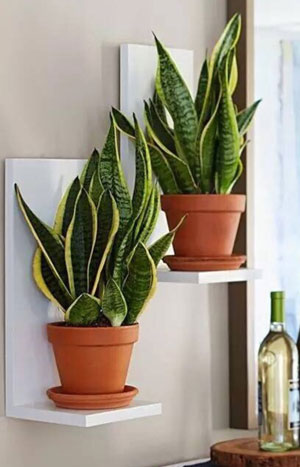
Common Pests/Diseases
Rarely will you encounter any serious pest or disease problems, but be on the lookout for white mealybugs, which can easily be removed with cotton swabs dipped in 70% rubbing alcohol (not 99%—this strength will kill plants).Snake Plant Companion Plants
There are so many house plants to choose from now, all of which work well with Sanseveria. I personally think that a collection of palms, such as the Kentia palm (Kentia forsteriana), Areca palm (Chrysalidocarpus Lutescens), and parlour palm (Chamaedorea elegans) are ideal. They offer diversity, create a tropical feel, and soften the aesthetic. Try adding the cast iron plant (Aspidistra elatior) and Chinese evergreen (Aglaonema christina) and you have yourself a miniature tropical oasis!It's also great to have a succulent collection. These could include the money plant (Cressula ovata), aloe vera (Sempervirens), Hobbit Jade (Crassula) and the fabulous ZZ plant (Zamioculous zamifolia). All of these will prove to be great companions to your mother-in-law's tongue plant and are pretty easy to look after.
Have a go at creating your own plant collection, or even a Sanseveria grouping. Along with those plants listed above, they really are a pleasure to own, and easy to maintain. They create a living focal point that not only looks great, but also helps to remove harmful toxins from the air, keeping you healthy and happy.
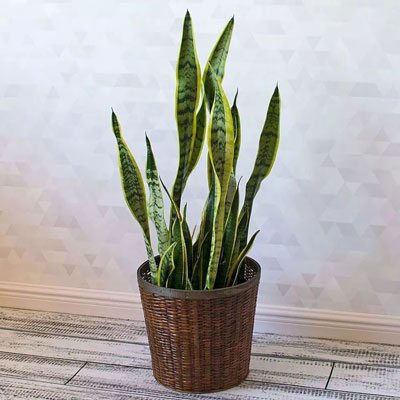
Snake Plant Toxicity
Mother-in-law's tongue plant leaves contain poisonous toxins, (saponins), which can cause serious gastric problems if eaten. They’re toxic to cats, dogs, rabbits, and birds, so ensure they’re kept at a distance to avoid unfortunate mishaps. Remember to always wash your hands after handling your plant or soil, especially when preparing cuttings and removing any damaged leaves.Latest Updated
- Benefits of Bugleweed - 7 Science-backed Health Benefits
- Bugleweed Dangers & Side Effects - Is It Poisonous?
- How to Plant Evergreen Trees - What You Should Know
- When to Plant Evergreens - Grow Guide for Evergreen Trees
- 12 Wonderful Evergreen Shrubs for Your Garden
- 12 Popular Evergreen Plants with Pictures for Beginners
- When And How To Prune A Lilac Bush Like a Pro
- How to Grow & Care for Lilac Vine (Hardenbergia Violacea)
- Japanese Lilac Tree (Syringa Reticulata) Care & Propagation Guide
- Shumard Oak Pros and Cons - What to Know
Popular Articles
- Winter maintenance of Antirrhinum Majus
- How to Grow Terminalia Mantaly Tree
- How to Grow and Care for Crossostephium Chinense
- How to grow Antirrhinum Majus in spring
- Peristeria Elata (Dove Orchid) Profile: Info & Care Guide
- Underwatered Snake Plant (Sansevieria Trifasciata) - Signs And How To Fix
- How to Care for Brazilian Jasmine Plant (Mandevilla Sanderi)
- How to Grow & Care for Graptopetalum Purple Delight in Summer
- Rosa Chinensis (China Rose): Plant Growing & Care Tips
- How to Care for Baby Sun Rose (Aptenia Cordifolia)
